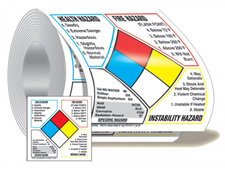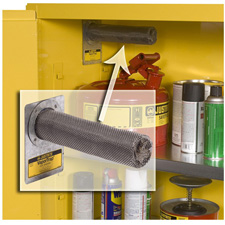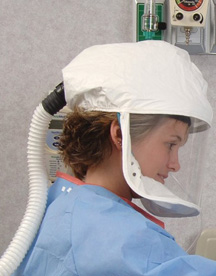| The Home page of ILPI's Safety Data Sheet (SDS) Resource, the leader in SDS information since 1995! | |
| The history and philosophy behind this resource. | |
| A curated collection of books and reference materials concerning Safety Data Sheets and closely related topics. | |
| Paste your plain text SDS into the SDS-Demystifier, and it will be converted into a hypertext-enriched document with links to detailed explanations of each key term. | |
| An extensive list of frequently asked questions about Safety Data Sheets including regulations, content, compliance, and more. | |
| A humorous take on Safety Data Sheet jargon. Fill in the blanks on our entry form to generate a personalized Unsafety Data Sheet to share with your coworkers. | |
| Since 1995, we've maintained this massive curated list of the best places to find Safety Data Sheets on the Internet. | |
| You are here! Way more than a glossary, this hypertext-enhanced resource covers hundreds of SDS-related terms and expert knowledge. Each entry includes both the SDS relevance and links to additional authoritative resources. | |
| Archived results of Safety Data Sheet related polls taken by some of our millions of site visitors | |
| The OSHA regulations behind SDS regulations, including the inspection guidelines and over 400 official interpretations letters under the Hazard Communication Standard | |
| Commercial suppliers of SDS authoring and management software as well as cloud compliance services. | |
| Commercial companies that will create SDS's for your specific needs as well as SDS translation companies. |

Safety signs, banners, and scoreboards? Get yours at Safety Emporium!

Communicate workplace hazards with handy labels from Safety Emporium.
Definition
Volatile Organic Compounds (VOC's) are organic chemicals that have a high vapor pressure and easily form vapors at normal temperature and pressure.
The term is generally applied to organic solvents, certain paint additives, aerosol spray can propellants, fuels (such as gasoline, and kerosene), petroleum distillates, dry cleaning products and many other industrial and consumer products ranging from office supplies to building materials. VOC's are also naturally emitted by a number of plants and trees.
TVOC stands for Total VOC's and is the concentration of all VOC's in a given sample (there may be several different VOC's present in a sample).
A VOC number, VOC rating, or VOC content expresses the amount of volatile material in a sample, either in pounds per gallon, grams per liter or as a percentage by mass.
Additional Info

Keep your workplace safe by using the VaporTrap™ Filter for VOC Vapors from Safety Emporium.
VOC's are an important health and environmental concern for several reasons:
- Some VOC's can be hazardous to your health when inhaled. For example, benzene is a probable human carcinogen and toxic. Likewise, formaldehyde is both an irritant and a sensitizer. Many VOC's are flammable.
- VOC's from outgassing of fabrics, building materials etc. are an important contributor to sick building syndrome (SBS). For more on SBS see Further Reading below.
- VOC's such as hydrocarbon (gasoline, petroleum distillates) emissions from cars and trees are important contributors to photochemical smog.
- Some VOC's such as methyl tert-butyl ether (MTBE, once added to gasoline to make it burn more cleanly) have a fair solubility and rather high mobility in groundwater, leading to the contamination of drinking water wells.
VOC's can be removed from air or water using special filtration systems. For example, activated charcoal absorbs many organic materials, but it has a limited capacity, is not an indicating adsorbent (so you won't know when it has reached its limit) and does not adsorb all materials.
SDS Relevance
Minimize or eliminate the use of VOC's whenever possible (see item #2 under Further Reading below). If you must use a VOC, minimize your exposure by using proper engineering controls such as a fume hood or other form of local exhaust ventilation. Gloves, a respirator and/or other appropriate personal protective equipment may also be necessary if the hazard can not otherwise be reduced to acceptable levels.
Whenever using a flammable material use adequate ventilation and remember that vapors may travel large distances. Heavier-than-air vapors (as most organic vapors are) can "pool" in low-lying areas, leading to an explosion when ignited by a flame, spark or static electricity. There are several reports each year of people blowing up their basements and themselves when using floor sealers etc. in a basement where the furnace or hot water heater pilot light ignited VOC's that had reached their lower explosive limit.
Books Available
NOTE: We may collect a share of sales or other compensation from the links in the following list:
- "Volatile Organic Compound Analysis in Biomedical Diagnosis Applications", Paperback, 292 pages, 2021. Estimated price $99.00.Info and/or order.
- "Progress in Volatile Organic Compounds Research", Hardcover, 2020, 228 pages. Estimated price $56.67. Info and/or order.
- "Volatile Organic Compounds in Environment", Paperback, 2017, 130 pages. Estimated price $46.90. Info and/or order.
- "Control of Volatile Organic Compound Emissions: Conventional and Emerging Technologies", Hardcover, 288 pages, 2000. Estimated price $219.50. Info and/or order.
- "Volatile Organic Compounds in the Atmosphere", Hardcover, 512 pages, 2007. Estimated price $206.66. Info and/or order.
Further Reading

Breathe easy with respirators and accessories from Safety Emporium.
- Technical Overview of Volatile Organic Compounds at the US EPA.
- Volatile Organic Compounds' Impact on Indoor Air Quality at the U.S. EPA.
- Volatile Organic Compounds in Your Home at the MN Department of Health.
- UMass Lowell hosts the Toxics Use Reduction Institute which has numerous resources for safter alternatives to traditional VOC's.
- VOCs: Paints, Cleaners and Other Solvents by the Montgomery County (Maryland) DEP provides info and tips about VOC's.
- Maximum VOC contamination levels in water and their health effects at the Florida DEP.
- Acute Exposure Guideline Levels for Selected Airborne Chemicals: Volume 20 (2016), is available as a free download from the National Academies Press.
- VOC's - Vapors in the Air, Dissolved in Groundwater at the US Geological Survey details how VOC's are common contaminants in groundwater.
- The GreenScreen® "Tool Box" helps identify chemicals of high concern and safer alternatives.
- Safer Chemical Ingredients List maintained by the US EPA .
- Volatile Organic Compounds in Air: Sources, Distribution, Exposure and Associated Illnesses in Children, a review at the Annals of Global Health, 2018, 84(2), pp.225-238.
- Pilot Lights at InterNACHI® describes what happens when pilot lights and VOC's mix.
See also: engineering controls, flash point, flammable limits, fume hood, NFPA, ventilation.